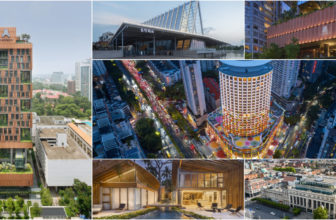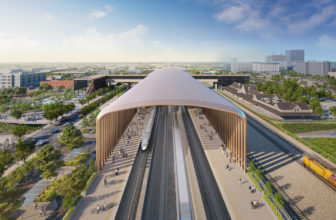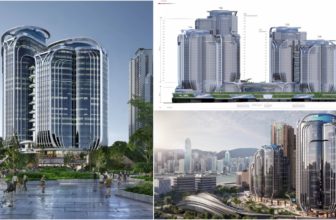Aga Khan Award for Architecture, presented once every three years, has officially announced the six exemplary winning projects of 2016’s award. The Aga Khan Award was established by Aga Khan in 1977 and is rewarded to not only projects that achieve architectural excellence, but must also be an architectural project that works on improving the overall quality of life.
While 19 candidates were shortlisted, the top five projects are to receive a 1$ million dollar prize. 2016’s winners are to join the list of previous years’ winning projects that include buildings designed by: Zaha Hadid, Norman Foster,Charles Correa, Frank Gehry, Jean Nouvel and Hassan Fathy.
His Highness the Aga Khan appoints the award’s “Master Jury” who establish the eligibility criteria for project submissions and the theme of the competition projects, based on the priorities and issues in the architecture discourse
In collaboration between the Aga Khan Program for Islamic Architecture at Harvard University and the Massachusetts Institute of Technology (MIT), an archive called ArchNet is a major online resource of architecture in Muslim societies. This archive in established as a part of the Aga Khan Trust for Culture to improve the way Islamic art, architecture, visual culture and urbanism are taught. It also aims to increase the profile of the Islamic cultural heritage in the modern Muslim world.

THE SYDNEY OPERA HOUSE – 2010 – Sydney, Australia – Photograph by: JACK ATLEY / www.jackatley.com – for The Sydney Opera House – PICTURE MUST NOT BE SOLD FOR ANY COMMERCIAL SALE WITHOUT EXPRESS WRITTEN PERMISSION BY JACK ATLEY – www.jackatley.com
The Master Jury shortlisted and announced the winning projects of 2016 Aga Khan Award of Architecture. The Jury compromised the following members:
-Suad Amiry, Founder, Riwaq Centre for Architectural Conservation, Ramallah
-Emre Arolat, Founder, EAA-Emre Arolat Architecture, Istanbul
-Akeel Bilgrami, Sydney Morgenbesser Professor of Philosophy, Columbia University, New York
-Luis Fernàndez-Galiano, Editor, Architectura Viva, Madrid
-Hameed Haroon, Chief Executive Officer, Herald Publications, Karachi
-Lesley Lokko, Head, Graduate School of Architecture, University of Johannesburg
-Mohsen Mostafavi, Dean, Graduate School of Design, Harvard University, Cambridge
-Dominique Perrault, Founder, Dominique Perrault Architecture, Paris
-Hossein Rezai, Director, Web Structures, Singapore
The jury and commented on each design off the winning list:
Bait Ur Rouf Mosque, Dhaka, Bangladesh | Marina Tabassum Architects
Designed by Marina Tabassum Architects, Bait Ur Rouf Mosque in Dhaka Bangladesh, the Mosque is composed of a square that lies on a high plinth, preventing floodwater from entering the structure and separating between the sacred site and the busy street.
“An adherence to the essential – both in the definition of the space and the means of construction – was crucial in formulating the design of Bait ur Rouf Mosque. With land donated by her grandmother and modest funds raised by the local community, the architect has created an elemental place for meditation and prayer.
There are two structural systems in place – the load-bearing brick walls that define the outer perimeter and the smaller spaces, and the reinforced-concrete frame that spans the column-free prayer hall. The brick walls exploit the depth between the outer square and the inner cylinder, allowing http://www.akdn.org/architecture for buttressing in the interstitial space. This in turn makes it possible for panels between the load-bearing structure to have a jali of brick, leaving out alternate bricks and rotating them. In the prayer hall itself a simple vertical gap in the brick denotes the direction of the qibla, but the recess is splayed so that worshippers are not distracted by sight lines onto the busy street. What they see instead is sunlight bouncing off the wall behind. Awash with light, open to the elements, the mosque ‘breathes’”
On this context, the Jury comments on the design came as follows: “In a transitional area caught between urban hyper-density and rural proximity, the terracotta mosque is an exquisitely proportioned building that is both elegant and eternal. Funded primarily by community donors, the mosque design challenges the status quo and understands that a space for prayer should elevate the spirit. The mosque does so through the creation of an interior space that is rich with light and shadow, but at the same time possesses a robust simplicity that allows for deep reflection and contemplation in prayer.”
Friendship Centre, Gaibandha, Bangladesh | Kashef Chowdhury + URBANA
Acting as a training facility for the NGO Friendship, the centre is located in a region with buildings’ heights over 2.4m off the ground.
“The centre is a training facility for the NGO Friendship, which works with communities living in the rural flatlands of northern Bangladesh. In this region permanent buildings are conventionally raised 2.4m off the ground, to mitigate flooding, but the budget did not allow that here. Instead, an earthen embankment was built around the site, with stairs leading down into the building from open ends. Adopting the vocabulary of a walled town, the programme is organised around a series of pavilions that look inwards onto courtyards and reflecting pools. Because of the embankment wall, there is no horizontal light, so in essence the centre is top-lit. This connection, between an architecture of the land and the light coming down from above, makes for a very elemental building.”

The jury commented on the adaptability of the design approach within all the project : “The integrative design approach is registered in every aspect of the project, and at every scale. The imbrication of outdoor and indoor spaces, together with the treatment of the roofscape, make this an unusual and innovative building. With its spaces sunk into the ground and the vegetation growing on its roofs, the compound blends beautifully into the natural surroundings. Its relationship to the landscape and to history and archaeology is remarkable in every way.”
Hutong Children’s Library and Art Centre, Beijing, China | ZAO| standardarchitecture, Zhang Ke
Benefiting all local community, the architect designed viewing platforms through finding better use for old buildings.
The hutongs of Beijing are fast disappearing. The residential compounds, with their layering of spaces and multiple courtyards, are often viewed as messy and insalubrious – almost as slums. If they find a place in the modern city, it is often in sanitised form, as a tourist attraction, filled with boutiques. The attempt to find a new use for this traditional building form – one that would benefit the local community – motivated this proposal for a space that would serve both the pupils from the nearby primary school and the hutong’s remaining, mostly elderly, residents. Besides a children’s library and exhibition space, the centre hosts a local handicrafts studio and classes in painting and dance.
As for the Jury comments: “The hutong provides an example of how the adaptive re-use of an older building can become the basis for a new form of micro-urbanism that constructs productive reciprocities between the private and the public. This is an approach that can be potentially replicated in other locations and within a diversity of communities.”
Issam Fares Institute, Beirut, Lebanon | Zaha Hadid Architects
The research centre for public policy and international affairs, viewed as a piece of art in AUB campus, with a surface area of 3,2000 square meters and six stories has a program that includes various facilities as research spaces and administration offices, seminar and workshop rooms, an auditorium, reading room, recreational lounge and roof terrace.
Responding to the givens of the site, the architects significantly reduced the building’s footprint by cantilevering a large part of the structure over the entrance courtyard – a move that also draws the space of the adjacent Green Oval towards the base of the new building. The existing landscape is preserved, including all of the old trees, which form a kind of datum line determining the height of the institute, as is evident from a look at the south facade. Further connections with the landscape are established by the roof terrace, with its expansive views, and by the circulation ramp that snakes smoothly through the trees to the southern entrance on the second floor.
Jury comments: “The building makes a courageous – and at the same time fully respectful – contribution to the multilayered physical environment of this historic and rooted university campus. With its simple, exposed concrete surface and strong volumetric presence, it is an elegant yet unique solution to a complex and special context.”
Superkilen, Copenhagen, Denmark | BIG + Topotek 1 + Superflex
With diverse contexts and objects of origins in Superkilen urban park, the users are allowed to experience and encounter different objects in their everyday life experience.
Superkilen is a kilometre-long urban park located in Nørrebro, a diverse and socially challenged neighbourhood of Copenhagen. Designed by architects BIG-Bjarke Ingels Group, artists Superflex and landscape architects TOPOTEK 1 in collaboration with the local – predominantly Muslim – community, the park takes the historical themes of the universal garden and the amusement park and translates them into a contemporary urban setting. With a healthy dose of irreverence, it sheds light on the positive dimensions of cultural diversity and invites people – young and old – to play.
Jury commented on the diversity of the users and its challenges in the design: “Living with people who differ – racially, ethnically, religiously or economically – is the most urgent challenge facing contemporary civil society. At a time of growing global uncertainty and insecurity, it has become fashionable to talk in terms of ‘worlds’ – the third world, the Islamic world, the Arab world – as though these occupy a parallel universe, disconnected from the rest and subject to different rules. Superkilen, a new urban park in one of Copenhagen’s most diverse and socially challenged neighbourhoods, emphatically rejects this view with a powerful mixture of humour, history and hubris.”
Tabiat Pedestrian Bridge, Tehran, Iran / Diba Tensile Architecture, Leila Araghian + Alireza Behzadi
The bridge connects between two parks in a city and a dense urban zone through adopting and following the topography of the site.
Tabiat Pedestrian Bridge spans a busy highway to connect two parks in a city with a very dense urban fabric and mostly utilitarian architecture. More than a point of connection between two discrete green zones, the bridge is a popular gathering place for the people of Tehran, offering numerous seating areas over its three levels and restaurants at either end. Like many such green spaces within urban areas, it has come to serve as a locus of identity for the city and its inhabitants.
Jury comments: “The apparent reinterpretation of the original brief, which called for a straightforward connection between two parks, has transformed a ‘bridge’ into a ‘destination’. Inviting people to congregate, interact and appreciate the vista in every direction, the bridge has become a promenade and one of the most successful public spaces in modern Tehran.”
Chaired by His Highness the Aga Khan, the Award is governed by a Steering Committee that includes:
• His Highness the Aga Khan (Chairman)
• David Adjaye, founder and principal architect of Adjaye Associates, which has offices in London, New York and Accra
• Mohammad al-Asad, the founding director of the Center for the Study of the Built Environment in Amman, Jordan
• Francesco Bandarin, Assistant Director-General for Culture at UNESCO, Paris, France
• Hanif Kara, a practicing structural engineer and Professor in Practice of Architectural Technology at the Graduate School of Design at Harvard University
• Kamil Merican, founding partner of GDP Architects Malaysia
• Azim Nanji, currently Special Advisor to the Provost at the Aga Khan University and a Member of the Board of Directors of the Global Centre for Pluralism in Ottawa
• Professor Gülru Necipoglu, Aga Khan Professor of Islamic Art at Harvard University;
• Brigitte Shim, a principal in the Toronto-based design firm Shim-Sutcliffe Architects and Professor at the John H. Daniels Faculty of Architecture, Landscape and Design at the University of Toronto
• Yu Kongjian, founder and dean of the College of Architecture and Landscape and the Changjiang Chair Professor of Design, at Peking University
This year’s awards ceremony was held in Al Ain, Abu Dhabi’s Al Jahili Fort which is considered a World Heritage Site.








